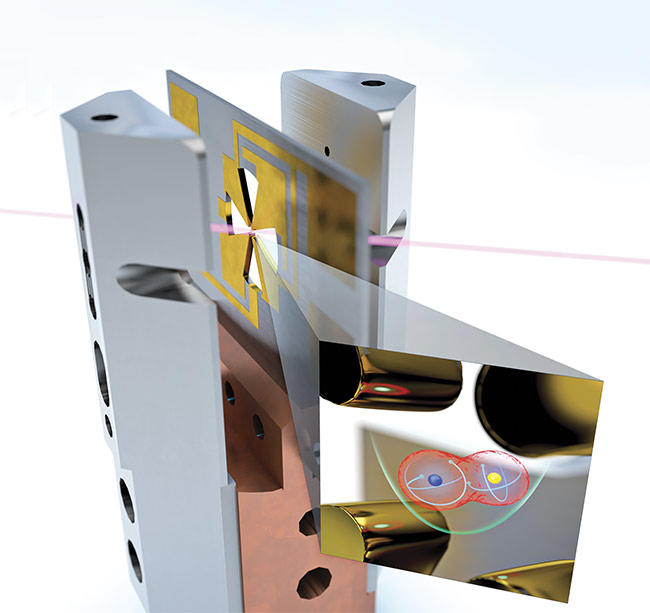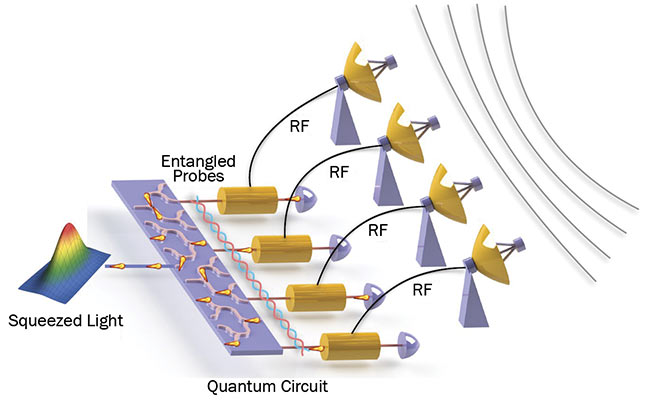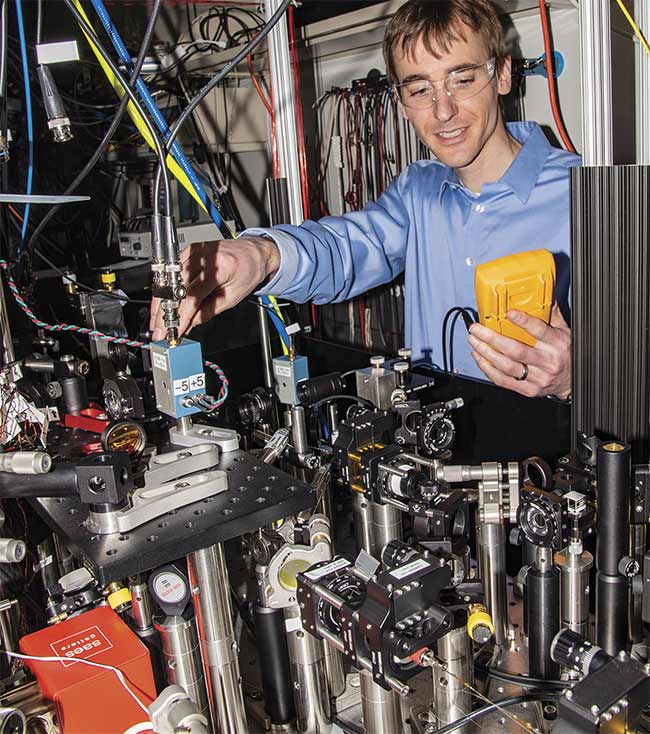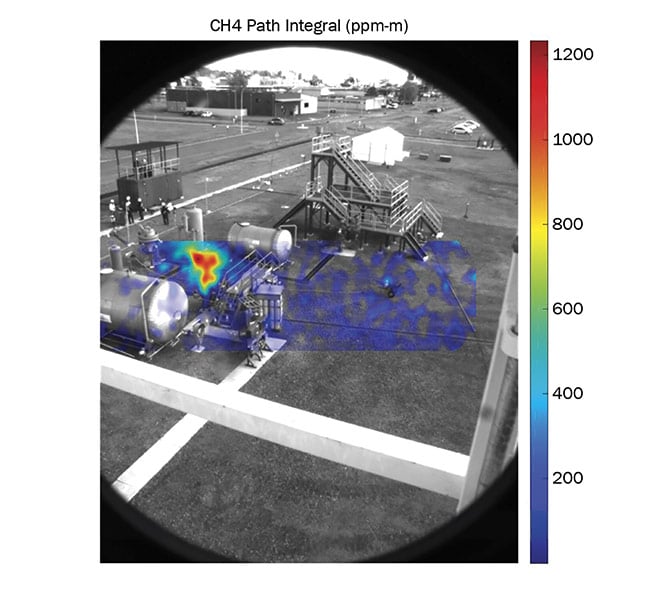Leveraging entanglement and other effects from the quantum realm could have an outsize impact on sensor arrays, precision clocks, and greenhouse gas detection.
HANK HOGAN, CONTRIBUTING EDITOR
While the quantum world may seem abstract and remote from day-to-day life, researchers are discovering that quantum effects such as photon entanglement could improve the performance and precision of everyday tools. Advancements in quantum metrology could help sharpen sensor location data, improve the precision of atomic clocks, or enable more versatile detectors for sensing greenhouse gas emissions.

An aluminum ion (blue dot) and a magnesium ion (yellow dot) provide the source of clock ticks. Entangling multiple ions could improve the precision of such clocks. NIST has leveraged the quantum states
of trapped ions and used their
resonance frequencies as
ultraprecise clock ticks. Courtesy of NIST.
The interest in quantum-level effects is driven by the prospect of vastly more accurate sensing with little additional cost, according to Tom Hausken, a senior industry adviser to Washington, D.C.-based OSA Industry Development Associates (OIDA), a division of The Optical Society (OSA). Hausken is principal author of the recently released “OIDA Quantum Photonics Roadmap,” a report that describes the challenges of leveraging quantum technology to improve sensing, metrology, and other fields. Potential application areas cited include atomic clocks, gravimeters, lidar systems, magnetometers, and medical imaging. OIDA reported that quantum techniques could have an impact on these fields and other applications as soon as 2030.
Better sensor arrays
The use of quantum effects on quantum metrology is already appearing in research conducted by Zheshen Zhang, an associate professor of materials science and engineering and optical sciences at the University of Arizona. A group of researchers headed by Zhang recently demonstrated a reconfigurable sensor network powered by continuous-variable multipartite entanglement. Their work indicates that quantum techniques could enhance the performance of a network of radio frequency (RF) sensors1.

An artist’s conception of an entangled radio-frequency photonic sensor array that leverages quantum effects to more precisely measure average amplitude or other global parameters. Such quantum techniques could improve localization accuracy. Courtesy of Zheshen Zhang/University of Arizona.
What makes the research notable is that, to date, most quantum metrology demonstrations have focused on improving the performance of a single sensor, but many applications rely on arrays of sensors that operate jointly to enable distributed sensing capabilities.
In classical metrology, sensors in an array operate separately. Each takes measurements independently of the others. The noise from each sensor is additive, Zhang said. In an array able to leverage quantum entanglement, however, the noise from each sensor would cancel out that of the others, thereby improving the array’s signal-to-noise ratio and overall performance.
In a proof of concept, Zhang and his group showed that this was possible by converting RF signals into optical photons and entangling them to improve a sensor array’s ability to estimate the arrival angle or average amplitude of an RF signal by more than a factor of two. Improvements to the light source could enable a tenfold improvement, Zhang said.
The experimental network developed by his group comprised three sensor nodes, each equipped to detect RF signals. By tailoring the continuous-variable multipartite entangled states, the researchers were able to reconfigure the entangled sensor network to maximize distributed RF sensing functions, such as measuring the angle of arrival of an RF field. The resulting sensitivities could introduce new levels of precision for distributed quantum sensing in applications that would benefit from ultrasensitive positioning, navigation, and timing. According to Zhang, the research could also aid other applications, such as cameras with pixel-based sensor arrays or phased-array radar detectors.
An important point is that these improvements only apply to global parameters, such as the angle of arrival for a signal or a signal’s average amplitude. So the technique cannot make a single pixel into a better sensor, but it can improve the performance of an array.
For example, the location accuracy that an indoor localization sensor can achieve is established, to a degree, by its ability to estimate the angle of arrival of an RF signal, which qualifies as a global parameter. For positioning outdoors, measuring the average amplitude of an RF field across several sensors — another global parameter — can be converted into timing measurements that could improve the location accuracy achievable by a GPS sensor.
Quantum ticks
Photonic technologies are valuable in quantum metrology and sensing applications because photons, once entangled, tend to stay entangled for relatively long periods. Photons can also put other particles such as ions into entangled states, cool them down, or probe them.
These capabilities could benefit the development of future atomic clocks, which are the most precise timekeeping devices available today. The oscillator in an atomic clock is a superposition of two quantum states of an atom. The energy difference between these two states is defined by a resonance frequency, which is the tick rate of the clock.
The National Institute of Standards and Technology (NIST) has used the resonance frequencies of the quantum states of trapped ions to develop ultraprecise clock ticks, according to David Hume, a physicist in the Ion Storage Group of NIST’s Time and Frequency Division in Boulder, Colo. After demonstrating a record for precision timekeeping with a single ion, NIST has moved to using more and more ions.
The next step may be to entangle ions with one another. According to Hume, 10 entangled ions could give an order-of-magnitude improvement in clock precision. Achieving the same effect using classical methods would require trapping 100 ions.
Entangling ions may not be costly since ultrahigh performance clocks already incorporate many of the requirements for quantum metrology, including a carefully designed ion or atom trap, laser cooling, and coherent control of the state of the particles, Hume said.
“Optimistically, turning a many-ion clock into a quantum-enhanced many-ion clock could be just a ‘software upgrade’ through programming a new series of laser pulses to make entangled states,” he added.

NIST physicist David Leibrandt adjusts a laser in a single aluminum ion clock. Lasers are vital operating components of atomic clocks, which quantum metrology could improve based on the resonance frequency of ions. Courtesy of NIST.
More precise timekeeping has several benefits. The extremely precise clocks at NIST and elsewhere could provide the basis for the synchronization that is fundamental to telecommunications worldwide.
Quantum techniques could also benefit efforts to develop more portable atomic clocks, which must be able to operate in noisier environments. Such clocks could map Earth’s gravitational potential by measuring minute changes in the passage of time brought about by a location-dependent gravitational field. Changes in local gravity also provide clues as to what lies underground, potentially providing
valuable geological information for
seismology, mining, and other areas of interest.
Sensing greenhouse gases
Quantum techniques could enhance tools for assessing and understanding the environment. Applied to lidar, quantum sensing and metrology methods could help detect methane and other greenhouse gases at greater distances, which would be of interest to wellhead and pipeline operators, as well as end users in other markets.
Bristol, England-based startup QLM Technology Ltd. is using time-correlated single-photon counting to perform optical gas detection, according to CEO Murray Reed. The company is exploring the use of entangled photons as a way to extend the capabilities of its products.
Currently, QLM is rolling out what it
describes as a unique combination of single-photon lidar and tunable diode laser absorption spectroscopy. Its gas detection technology depends on single-photon avalanche photodiodes operating around the 1.5-µm wavelength. The system can adjust this wavelength to target absorption peaks for specific greenhouse gases, such as carbon dioxide, methane, or
ammonia. QLM’s system generates
10 mW of outgoing power to capture a
returning signal in the 10- to 100-pW range, which means about a billion photons go out for every one that comes back. This technique makes it possible to clearly detect a targeted gas up to 200 m away and perhaps farther, Reed said.
Alternative approaches to greenhouse gas detection rely on temporary placement of expensive cooled infrared cameras, which can leave a particular site unmonitored for months at a time. This is a problem because most leaks of greenhouse gases at such sites are super-emitters — big leaks over a long period of time.
QLM’s technology could prevent super-emitter events by enabling continuous monitoring. Currently, the company’s technique is more effective for detecting small molecules. To target pollutants characterized by larger molecules, the wavelength of the system’s source would need to more than double, from about 1.5 to 3.2 µm. The sources and detectors available in these wavelengths can be relatively expensive or require cooling.

Single-photon detectors can sense the presence of greenhouse gases such as methane around wellheads and pipelines, or in a test setup (shown). Quantum entanglement could be used to convert interrogative wavelengths up and down to expand the number of atmospheric pollutants these systems can detect. Courtesy of QLM Technologies.
This is where entanglement comes in, according to Xiao Ai, QLM’s chief technology officer. With help from John Rarity, a professor of optical communications at the University of Bristol and a QLM board member, the company is exploring how using pairs of entangled photons could effectively convert the outgoing and returning pulses to different wavelengths.
Although getting this technique to work is years off and presents formidable challenges, it could pay dividends by making optical gas detection in the mid-IR easier to accomplish. “With this way of achieving it, we do not require cooling, because the detector and laser are a classical 1.5 µM. It will be tunable by the conversion process,” Ai said.
The ripple effect
As these examples illustrate, the potential applications for quantum sensing and metrology may currently be small, but they hint at broader possibilities. Additionally, the impact of any single development in quantum technology may exceed early market opportunities. Together, these two factors help to explain the interest in quantum metrology and the motivation to advance the field quickly.
“Item one actually drives a lot of our market through sales to labs. Item two is about national security and competitiveness, not just the market itself. IBM doesn’t want to miss out; neither does the U.S. government,” OIDA’s Hausken said.
Reference
1. Y. Xia et al. (April 17, 2020). Demonstration of a reconfigurable entangled radio-
frequency photonic sensor network.
Phys Rev Lett, Vol. 124, Issue 15.